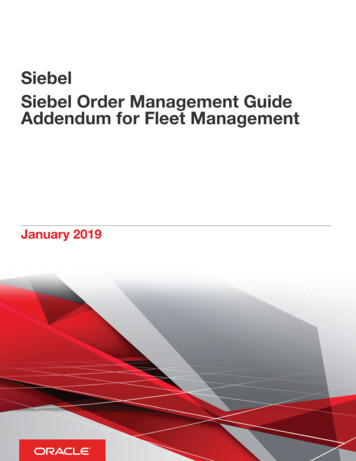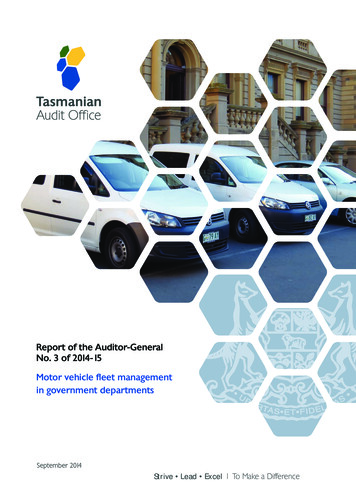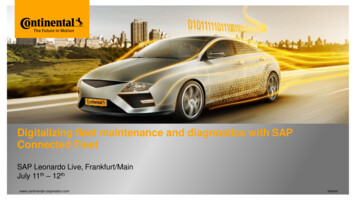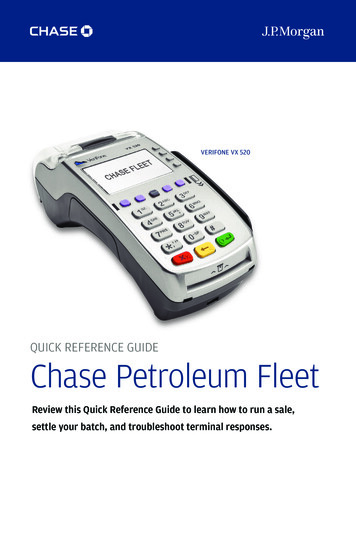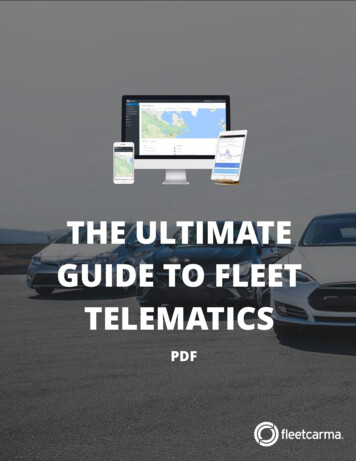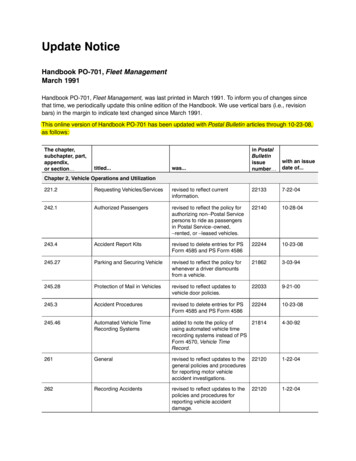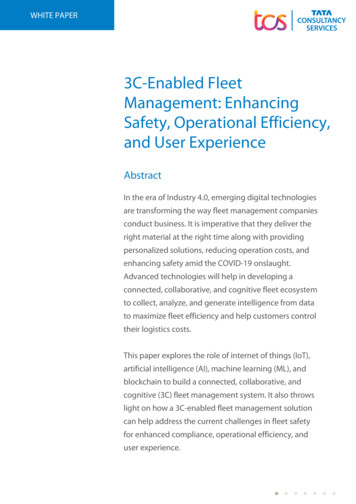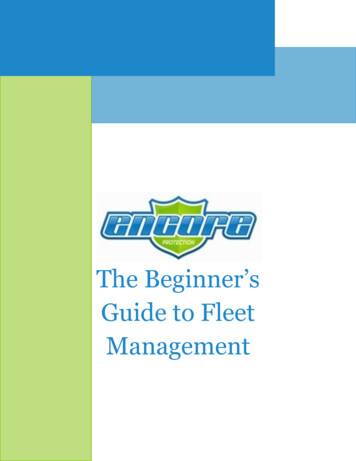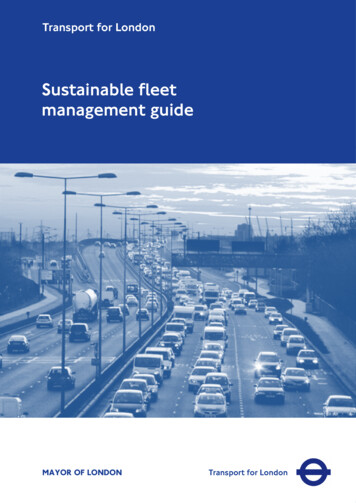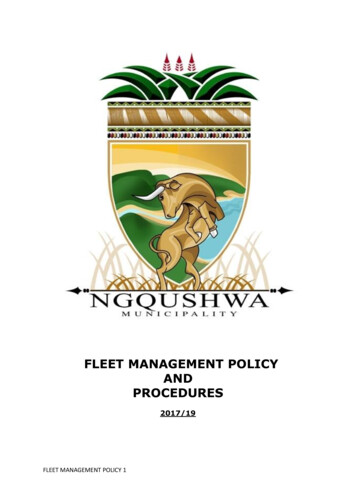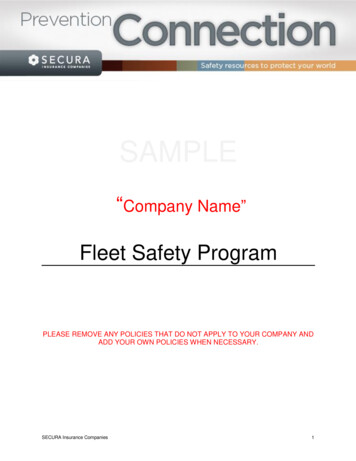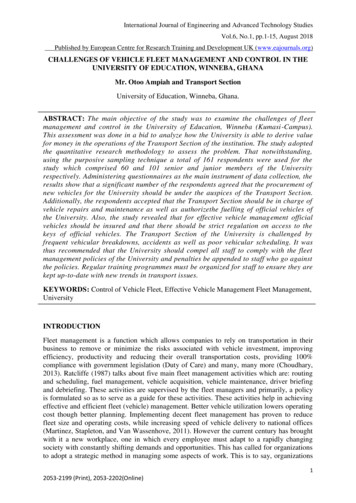
Transcription
International Journal of Engineering and Advanced Technology StudiesVol.6, No.1, pp.1-15, August 2018Published by European Centre for Research Training and Development UK (www.eajournals.org)CHALLENGES OF VEHICLE FLEET MANAGEMENT AND CONTROL IN THEUNIVERSITY OF EDUCATION, WINNEBA, GHANAMr. Otoo Ampiah and Transport SectionUniversity of Education, Winneba, Ghana.ABSTRACT: The main objective of the study was to examine the challenges of fleetmanagement and control in the University of Education, Winneba (Kumasi-Campus).This assessment was done in a bid to analyze how the University is able to derive valuefor money in the operations of the Transport Section of the institution. The study a doptedthe quantitative research methodology to assess the problem. That notwithstanding,using the purposive sampling technique a total of 161 respondents were used for thestudy which comprised 60 and 101 senior and junior members of the Universityrespectively. Administering questionnaires as the main instrument of data collection, theresults show that a significant number of the respondents agreed that the procurement ofnew vehicles for the University should be under the auspices of the Transport Sect ion.Additionally, the respondents accepted that the Transport Section should be in charge ofvehicle repairs and maintenance as well as authorizethe fuelling of official vehicles ofthe University. Also, the study revealed that for effective vehicle management officialvehicles should be insured and that there should be strict regulation on access to thekeys of official vehicles. The Transport Section of the University is challenged byfrequent vehicular breakdowns, accidents as well as poor vehicular scheduling. It wasthus recommended that the University should compel all staff to comply with the fleetmanagement policies of the University and penalties be appended to staff who go againstthe policies. Regular training programmes must be organized for staff to ensure they arekept up-to-date with new trends in transport issues.KEYWORDS: Control of Vehicle Fleet, Effective Vehicle Management Fleet Management,UniversityINTRODUCTIONFleet management is a function which allows companies to rely on transportation in theirbusiness to remove or minimize the risks associated with vehicle investment, improvingefficiency, productivity and reducing their overall transportation costs, providing 100%compliance with government legislation (Duty of Care) and many, many more (Choudhary,2013). Ratcliffe (1987) talks about five main fleet management activities which are: routingand scheduling, fuel management, vehicle acquisition, vehicle maintenance, driver briefingand debriefing. These activities are supervised by the fleet managers and primarily, a policyis formulated so as to serve as a guide for these activities. These activities help in achievingeffective and efficient fleet (vehicle) management. Better vehicle utilization lowers operatingcost though better planning. Implementing decent fleet management has proven to reducefleet size and operating costs, while increasing speed of vehicle delivery to national offices(Martinez, Stapleton, and Van Wassenhove, 2011). However the current century has broughtwith it a new workplace, one in which every employee must adapt to a rapidly changingsociety with constantly shifting demands and opportunities. This has called for organizationsto adopt a strategic method in managing some aspects of work. This is to say, organizations12053-2199 (Print), 2053-2202(Online)
International Journal of Engineering and Advanced Technology StudiesVol.6, No.1, pp.1-15, August 2018Published by European Centre for Research Training and Development UK (www.eajournals.org)are able to achieve their overall goals and meet the changing demands of businessenvironment if they are able to manage effectively the various sections of the organizations.The fleet (vehicle) section of an organization is therefore one of the areas which contributesgreatly to the achievement of organizational goal. This is because the fleet section isresponsible for the movement of both people and goods of the organization. This helps tospeed up business operations and processes. In other words, the pressure to deliver faster andcheaper has made vehicle utilization an important aspect of fleet management (Jonsson,2008; Waters, 2009). The pivotal role played by the fleet section has prompted organizationsto embrace fleet management. Fleet (vehicle) management can include a range of fleetmanagement functions such as vehicle financing, vehicle maintenance, vehicle telemetric(tracking and diagnostics), driver management, fuel management, and health and safetymanagement (Choudhary, 2013). Martinez, Stapleton and van Wassenhove (2011, p.404)define field vehicle fleet management as: “decision-making on repositioning and loadassignment for groups of transportation means operating in job locations remote from regularfacilities, offices, etc. to optimize performance”.The University of Education, Winneba in Ghana was established in September 1992 first, asUniversity College under PNDC Law 322. It was then called University College of Educationof Winneba. On 14th May 2004, the University of Education Act, 2004 (Act 672), wasenacted to upgrade the status of the University College of Education of Winneba to the statusof a full University. Currently the University has four satellite campuses, namely:WinnebaCampus, Kumasi Campus, Mampong-Ashanti Campus and Ajumako Campus. Since theinception of the University with the mandate of teaching, research and community service, nostudy has been undertaken in the area in fleet management. There had not been empiricalstudy on the challenges of vehicle fleet management and control in the University,considering the wider use of vehicles and movements involved with staff, materials andequipment.This is without prejudice to the fact that the campus-wide nature requires interplayand use of many vehicles and how it affects the general management of resources. It isagainst this backdrop that this study is necessary and the outcome could serve as a guide topolicy formulation in the University and contribute to knowledge in challenges of vehiclefleet management and control.Statement of ProblemThe establishment of effective administration of fleet management programme can have apositive impact on the cost effectiveness and efficiency of the location in fleet operation.It isbelieved that the role played by fleet management in the management and delivery of servicesin the University of Education, Winneba is very important and requires effective and efficientmanagement of fleet for optimum cost utilization in the areas of vehicles, fuel, spare parts,and other vehicle consumables. In recenttimes, it appears theUniversity has beenexperiencing some challenges in its vehicle management and administration. The policies andregulations on vehicle use, management and control for effective and efficient running ofactivities with the view of ensuring value for money has become a challenge. Recent reportindicates increasing cost in vehicle running and maintenance. This notwithstanding, there hasbeen no empirical study regarding the challenges of vehicle fleet management and control inthe University. This study intends to assess the extent to which these policies and regulationsare enforced to ensure effective vehicle utilization in the University. In other words, thecurrent study intends to assess the challenges of fleet management and control in22053-2199 (Print), 2053-2202(Online)
International Journal of Engineering and Advanced Technology StudiesVol.6, No.1, pp.1-15, August 2018Published by European Centre for Research Training and Development UK (www.eajournals.org)University.Considering the above resource problem, the following research questionsformulated would be answered in the study. What are the existing vehicle management policies (if any) in the University ofEducation, Winneba? What are the challenges in fleet management in the University and how could they beaddressed?REVIEW OF RELATED LITERATUREChallenges of Vehicle Fleet ManagementLockhead (1986) suggests that the failure of the road haulage industry is attributed to thefollowing challenges: poor road infrastructure, breakdowns, accidents, routing andscheduling, fuel shortage, and criminal activities.Indeed, according to Lockhead (1986), thefollowing signals are indicators of poor routing and scheduling; vehicles running longdistances when only partially loaded, vehicles covering excessive distances to reach theirdestination, large vehicles being used for running errands or making small-item deliverieswhich could have been accomplished more effectively and economically by other means. Theabove stated practices display inefficient fleet management and cost inefficiency that in turnbuilds on the failure of most automobile firms. This is one of the reasons why an appointedfleet manager has to possess good decision-making skills to prevent such events fromhappening.Ratcliffe (1987) states that since the oil price shocks in the 1970s, considerably moreattention has been paid to energy conservation than before. There are signs that this attentionis slackening due to the seeming abundance of energy. As the world economy pulls out ofrecession and energy requirements increase rapidly, the world could easily go back to thesituation it faced in 1979. Therefore, fuel being a non-renewable resource is affected byeconomic recession and thus also affects the transport sector, posing as a hindrance to theeffective management of the road haulage industry.Lockhead (1986) puts forward that thegreatest road haulage drawback is that of breakdowns. He emphasizes that an adverse impacton the economy’s reputation as customer response is delayed. Breakdowns are also anindicator of poor maintenance of vehicles and thus more time is spent idle than on a trip.Control on Fleet ManagementThe road safety organisation in Ghana has provided guidelines through its National RoadSafety Strategy III (2011-2020) to improve road and fleet safety in the country. According tothe strategy, the National Road Safety Commission (NRSC) has developed strategicframework aimed at halting the increasing trends of fatalities and injuries by 2015 andreducing same by 50% by the year 2020.Recruiting and selecting staff with the correct attitudinal and behavioural characteristics isvital to every organisation. Recruitment is the process of generating a pool of capable peopleto apply to an organisation for employment, and selection is the process by which managersand others use specific instruments to choose from a pool of applicants, the person(s) mostlikely to succeed in the job(s), given management goals and legal requirements (Bratton and32053-2199 (Print), 2053-2202(Online)
International Journal of Engineering and Advanced Technology StudiesVol.6, No.1, pp.1-15, August 2018Published by European Centre for Research Training and Development UK (www.eajournals.org)Gold, 2007). An organization’s ability to select competent employees will determine howsuccessful the organisation will become (Tandu, Abeki and Nnaa, 2008). Selection tools mustbe utilized in the selection process to acquire the right employees needed for a job.In a large survey of company car drivers in Great Britain, Lynne and Lockwood (1998) foundthat 11% of the drivers had taken a course of car driving training since first passing theirdriving test. Drivers who had received such training had an accident rate that was 8% lowerthan those who had not, though the difference was not statistically significant. However,Lynne and Lockwood (1998) indicate that it is possible that the selection of drivers fortraining may have been non-random. Drivers may have been selected for training becausethey had a poor accident record or, conversely, drivers who were more safety conscious mayhave volunteered for training.Employee’s performance appraisal is a tool for ensuring that an employee’s performance iscontributing to the achievement of business goals. Performance appraisal creates anopportunity for superiors (managers) to help employees to understand how their personalobjectives link to the overall business strategy (Williams, 2002).Reward refers to all of themonetary, non-monetary and psychological payments that an organisation provides for itsemployees in exchange for the work they perform (Bratton and Gold, 2007). Effective rewardsystems tap into the values and issues that are important to people. Theoretically, the mosteffective incentive programmes (Hagenzieker, 1988; Wilde, 1988, both cited in Janssen,1991): Provide an incentive that is proportional to the actual reduction in accident ratesachieved, Provide incentives that are based on group rather than individual contingency, Provide a large incentive to a small number of eligible drivers selected on randombasis, rather than a small incentive to all eligible drivers.Employee relation is concerned with the relationships between the policies and practices ofthe organisation and its staff, and the behaviour of work groups (Mullins, 2005).Organizations are able to achieve success when they involve their employees in the activitiesof the organisation. University vehicles are a property of University Council. In the publicsector, vehicles are acquired through: direct purchase by funds from Government orinternally/locally generated funds, donations, and projects. Apart from private universities notreceiving funds from the government for the procurement of vehicles, private universitiesalso acquire vehicles through the various means used by the public University.In some institutions, all pool vehicles and dedicated vehicles are procured by the FleetManagement Office. The Fleet Management Office provide information and advice asnecessary in the preparation of business cases to justify the acquisition of dedicated vehiclesby departments (Massey University Policy Guide, 2008) Properly prepared purchase ordersare processed through the Purchasing Office. New vehicles are received and processed byFleet Management Services. Concerning vehicle maintenance, University vehicle repairs arecontrolled, monitored and overseen by the Director of Estates and Works Department,assisted by the Transport Officer. Before the vehicle is serviced or repaired, the end-usersseek authority from the office of the Director of Estates and Works Department. The EstatesDirector, through the Transport Officer inspects each vehicle due for service/repair to42053-2199 (Print), 2053-2202(Online)
International Journal of Engineering and Advanced Technology StudiesVol.6, No.1, pp.1-15, August 2018Published by European Centre for Research Training and Development UK (www.eajournals.org)establish the need. To establish this, the date of last service/repair and mileage is checked(ULVFMP, 2011). In some Universities, fuel is allocated through Fuel Advantage Cards orother system approved by University Council from time to time (Makerere UniversityTransport Management Policy Guidelines [MUTMPG], 2011). Universities may also have anemergency fuel tank for critical services. Other system of the procurement can be used inareas where fuel advantage cards are not used, which is the case for most of the pool vehicles– i.e., vehicles not attached to a particular University officer or project.University Vehicle Registration books are under the custody of the Director of Estates andWorks Department to ensure proper monitoring and accountability for the usage of allUniversity vehicles. Drivers use movement Logbooks for every journey made. The TransportOfficer and/or the vested supervisory control office determines the following criteria are metbefore releasing a University vehicle to an employee or authorizing an employee to use aprivate or personal vehicle on official University or State business: The person requesting vehicle use is, in fact, a University employee in active service. Written approval of the use has been given by an individual authorized by the TransportOfficer to grant such approval. The person has satisfactorily completed a University approved defensive driving courseand maintains a good driving record. The person has a valid driver’s license in his/her possession. The driver’s licence is of thecorrect class for the type of vehicle he/she is driving (MUTMPG, 2011).It is the responsibility of the University Estates Manager, through the Transport Officer tocontrol and regulate misuse of university vehicles. When misuse is discovered, it is theresponsibility of the Transport Officer to determine the cost and send notification to the ViceChancellor/Chief Financial Officer, the University Secretary and the Head/Director ofHuman Resources. Recovery of the cost of misuse is not to be considered a disciplinaryaction. In case of failure to recover the cost of misuse, the Transport Officer will determinethe kind of disciplinary action to be taken (MUTMPG, 2011).The Concept of Fleet ManagementManagement is the co-ordination of resources through the process of planning, organizing,directing and controlling in order to attain set organizational objectives (Gbadegesin and Ojo,2011). With the diverse nature of management, it has become a universal concept thatrequires of every manager to perform identical functions (Gbadegesin and Ojo, 2011), in anyformal organization whether profit-making or non-profit-making (Robins et. al., 2002).Wyrick and Storhaug (2003) believe that fleet management comprises all actions needed tomaintain and operate pieces of equipment throughout its life from the beginning stages ofequipment acquisition to the final stages of asset disposal. Such areas include: maintenanceand repair, inventory control, training, and safety issues. The above definitions throw light ontwo main objectives of fleet management: Firstly, to guarantee availability and costefficiency by effective procurement and sales (Wu, Hartman and Wilson, 2005), maintenance(Haghaniand Shafahi, 2002), safety and vehicle drivers management (Mejza, Barnard, Corsiand Keane, 2003), and secondly, to find the optimal vehicle routes through set of loads,subject to capacity (Powell and Carvalho, 1998) and time constraints (Powell, Carvalho,Godfrey and Simao, 1995).52053-2199 (Print), 2053-2202(Online)
International Journal of Engineering and Advanced Technology StudiesVol.6, No.1, pp.1-15, August 2018Published by European Centre for Research Training and Development UK (www.eajournals.org)Ratcliffe’s (1987) stated that there are five main fleet management activities. These are:routing and scheduling, fuel management, vehicle acquisition, vehicle maintenance, driverbriefing and debriefing. These activities are supervised by the fleet managers and primarily, apolicy is formulated so as to serve as a guide for those activities. Ratcliffe’s (1987) assertionaffirms to the fact that the University of Education, Winneba has encapsulated all the abovefleet management activities into what is known as Vehicle Management Policy. Theprovisions of this policy provide practical and constructive guidelines for the regulation ofvehicle transport operations in the University.Fleet Management Policy of UEWA summary of policy document available in the University under study and the nationalregulation pertaining to the disposal of vehicles which generally apply include the following: The University vehicles may be allocated or re-allocated by the Vice Chancellor to afaculty/institute/department/unit/section upon a recommendation of the TransportManagement Committee. Where a vehicle has been donated to a faculty/ institute/ department/ unit/ section fora specific project, the Vice Chancellor shall upon the recommendation of theTransport Management Committee, have the authority to reallocate the vehicle forofficial purposes on completion of the project. The Dean/Director/ Head of Department concerned shall be responsible for vehiclesassigned to his/her Faculty/Institute/Directorate/Department/Unit or Section. The Transport Management Committee will from time to time review regulations forthe efficient administration of University vehicles. The Registrar will from time to time review regulations for the efficientadministration of University vehicles. To assist in the efficient management and operation of University vehicles, theappropriate log books and requisition form(s) should be utilized in all instances exceptin an emergency to ensure accountability in vehicle management; and assess driverperformance.The Use and Control of Vehicles University vehicles are to be used by the faculty/institute/department/unit/sectionassigned for official assignments authorized by the head or the deputy officerfaculty/institute/department/unit/section only. Pool vehicle(s) use should beauthorized by the Registrar or a designated official, acting on his/her behalf. All vehicles shall be used for only official business of the University. A vehicle allocated to a particular faculty/ institute/ department/ unit/ section shall beunder the control of the Dean/Director/Head who shall ensure that the vehicle is in aroadworthy condition. Each faculty/ institute/ department/ unit/ section vehicle must be assigned a driverwho may be transferred by the Registrar on the recommendation of the Chief62053-2199 (Print), 2053-2202(Online)
International Journal of Engineering and Advanced Technology StudiesVol.6, No.1, pp.1-15, August 2018Published by European Centre for Research Training and Development UK (www.eajournals.org)Transport Officer periodically as may be deemed necessary. No unauthorized officerof the University shall be permitted to drive such vehicles without the expressapproval of the Registrar. The Transport Section shall periodically inspect the condition of all vehicles in thefaculty/ institute/ department/ unit/ section at the end of every academic year andsubmit reports on their condition to the Transport Management Committee. Subject to the exigencies of the work of a faculty/ institute/ department/ unit/ section,the Chief Transport Officer after consultation with the Dean/Director/Head mayauthorize the use of the vehicle of a faculty/ institute/ department/ unit/ section for anofficial business of the University. Staff may hire University vehicles for private use at approved rates. However,approval for such use of University vehicles by staff rests with the Registrar or ViceChancellor. Trucks and buses of the University should not be hired out to the public. Deans of Faculty/Heads of Department may apply on behalf of Faculties/Departmenton the use of University vehicles for field trips/excursions. The cost of such trips shallbe charged to the faculty/departments account. The approval of the Registrar or Vice Chancellor must be sought before the releaseany University vehicle to a government institution or any local authority. All University vehicles, other than those allocated to the faculty/ institute/ department/unit/ section shall be placed under the day to day control of the Chief TransportOfficer. That will constitute the pool vehicles. As much as possible, University officials travelling to common destinations forofficial business shall strive to use the same faculty vehicle or vehicle from thetransport pool to ensure judicious use of resources.Other important areas summarised in the policy document available in the University andalso for the national regulation pertaining to the disposal of vehicles which generally apply tothe study include: Storage/Parking Repairs/ Servicing and Maintenance Cost of Repairs/Servicing and Maintenance Procurement/ Donation of Spare Parts Insurance of Vehicles Accident Drivers/ Operators of University Vehicle Responsibility72053-2199 (Print), 2053-2202(Online)
International Journal of Engineering and Advanced Technology StudiesVol.6, No.1, pp.1-15, August 2018Published by European Centre for Research Training and Development UK (www.eajournals.org) Sanctions against Drivers/ Operators of University Vehicle Training of Transport Section Staff Fuelling of Vehicles Vehicle Replacement Disposal of VehiclesExisting VehicleMgt. PolicyVehicle Mgt.awarenessFactors affectingVehicle Mgt.Challengesaffecting VehicleMgtMeasures toovercome ConstraintsSource: Authors Field Work, (2017)Conceptual Framework of Vehicle Fleet ManagementAchieving value for money points to the utilisation of public resources in away that createsand maximises public value. Hence, from the conceptual framework above, the researcherseeks to maintain that to derive maximum utilization of University resources there is the needfor strong vehicle management policy control on the usage of vehicles belonging to theUniversity. It is understood that the vehicle management policy will provide a framework forcreating effective vehicle management environment and for effective utilisation of vehicles inthe University. The framework further proposes that an existing effective vehiclemanagement policy will also provide effective strategies to deal with challenges that emergeout of the vehicle policy implementation in the University. The interrelated parts of theconceptual framework could point out clear path on effectiveness and challenges of vehiclefleet management in the University when all parts are well co-ordinated.82053-2199 (Print), 2053-2202(Online)
International Journal of Engineering and Advanced Technology StudiesVol.6, No.1, pp.1-15, August 2018Published by European Centre for Research Training and Development UK (www.eajournals.org)RESEARCH METHODOLOGYThe study made use of quantitative research methods. A purposive sampling technique wasused to select 161 respondents for the study which comprised60 senior members and 101senior and junior staff. It is expected that the sample size would be adequate to serve as arepresentation for generalizing the results for the whole population. The study population wasthe entire working force of the University of Education, Winneba-Kumasi Campus. The staffstrength of the College is 270. Out of this number, 130 are teaching and non-teaching seniormembers and 140are senior and junior staff in the College (HR, UEW-K, 2015).In determining the sample size, an assumption of 95% confidence level was used, thus, thisprovided 0.05 as the margin of error. In substituting a 95% confidence level with a populationof 270 into the Slovin’s formula, the sample size of 161 was obtained.The sources of data forthe study were both from primary and secondary sources. Secondary data were obtained frominternet resources, journals, articles, publications, other documents available to the Universityand books. Through the administration of questionnaire too, the primary data were obtainedfor the study. The researcher made as many copies as possible and distributed the instrumentshimself, from office to office at random and made the needed follow ups till all the161 wereobtained.The data gathered from respondents were coded and analysed using the statistical package forsocial sciences (SPSS 16.0 version) software.The analysis of the data was tabulated to makeit simple for anyone to analyse and be converted into percentages to make it more meaningfulfor interpretation and then presented through diagrams, bar charts and tables to depict trendsand allow for comparison of findings. These enhanced the understanding of the findings andmade it more relevant for the purpose of the study.RESULTS AND DISCUSSIONThis section presents the results from the data analysis and further discusses the findings fromthe study.The data analysis was done with respect to the study objectives. Table 1 showsawarenessof a codified transport management policy summarised from the fieldwork.Existing Vehicle Management PoliciesTable 1: Awarenessof a codified transport management policyResponseYesNoTotalSource: Fieldwork (2017)Frequency11744161Percent (%)72.727.3100.0In Table 1, the researcher sought respondent’s view regarding their awareness of theavailability of a codified transport management policy. Out of 161 respondents, more thantwo-thirds (72.7%) indicated being aware of the existence of a codified transportmanagement policy whiles 44 respondents representing 27.3% were not aware of the policy.From the responses, it could be inferred that the University has in place a codified transport92053-2199 (Print), 2053-2202(Online)
International Journal of Engineering and Advanced Technology StudiesVol.6, No.1, pp.1-15, August 2018Published by European Centre for Research Training and Development UK (www.eajournals.org)management policy for effective fleet management in the institution that is known to majorityof its employees.The assessment of vehicle maintenance policy was based on five point Likert scale rangingfrom strongly disagree (1) to strongly agree(5).The participants were made to rate the fleetmanagement policy based on ;vehicle acquisition, driver briefing and debriefing, vehiclerouting and scheduling, vehicles repairs and maintenance as well as fuel management. Table2 shows the descriptive statistics of respondents’ view on the various aspects of the vehiclemanagement policy they know.With a mean score of 3.25, most respondents had knowledgeon vehicle acquisition, followed closely by driver briefing and debriefing (mean 3.24),vehicle routing and scheduling (mean 2.94), vehicle repairs and maintenance (mean 2.82)and fuel management (mean 2.75).Table 2: Descriptive Statistics on vehicle management policiesFleet Management Policy AreasVehicle acquisitionDriver briefing and debriefingVehicle routing and schedulingVehicle repairs and maintenanceFuel 5thSource: Fieldwork (2017)The result indicates that fleet management policies in the University place significantemphasis on vehicle acquisition. Fleet management comprises all actions needed to maintainand operate pieces of equipment througho
Fleet management is a function which allows companies to rely on transportation in their business to remove or minimize the risks associated with vehicle investment, improving efficiency, productivity and reducing their overall transportation costs, providing 100% compliance with gove
